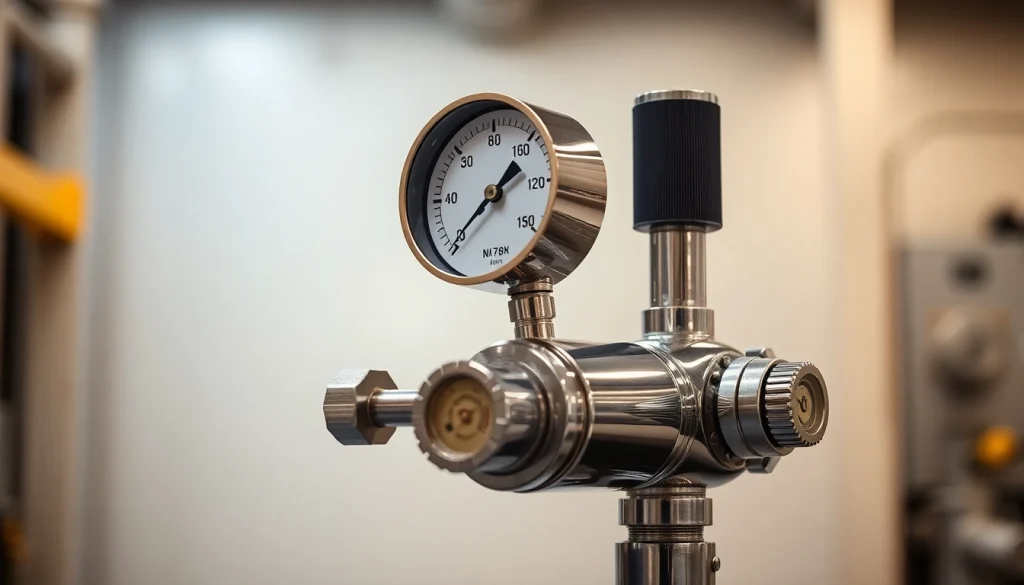Understanding Nitrogen Regulators
What is a Nitrogen Regulator?
A nitrogen regulator is a critical component used to control the pressure and flow of nitrogen gas from a high-pressure cylinder to a low-pressure system. This device ensures that nitrogen is delivered at a safe and usable pressure. Typically, nitrogen regulators are used across various industries, including food and beverage, pharmaceuticals, and manufacturing, where nitrogen’s inert properties are indispensable.
A nitrogen regulator typically consists of an inlet port that connects to the nitrogen cylinder, a pressure-reducing valve, and an outlet port leading to the application. Nitrogen regulators function by reducing the incoming pressure to a specific, adjustable output level, allowing for precise control over gas flow rates.
How Nitrogen Regulators Work
The operation of nitrogen regulators revolves around a pressure-reduction mechanism, which can be either single-stage or dual-stage:
- Single-Stage Regulators: These regulators reduce the pressure in one step. They are suitable for applications where the nitrogen pressure doesn’t need to be varied significantly. Single-stage regulators are simpler and typically more economical but can lead to pressure spikes if the cylinder pressure fluctuates.
- Dual-Stage Regulators: Featuring two pressure-reducing stages, these regulators provide more stable pressure control. They are better suited for situations where a precise, consistent flow rate is required, making them ideal for applications like laboratories and industrial processes.
The gas flows from the cylinder through a regulator, which has a diaphragm that senses the outlet pressure. As the pressure changes, the diaphragm moves to adjust the opening of the valve, allowing more or less gas to flow through to maintain the desired output pressure.
Common Applications of Nitrogen Regulators
Nitrogen regulators are integral across various sectors:
- Food and Beverage Industry: In this sector, nitrogen is often used for flushing, preserving, and dispensing products. Nitrogen regulators ensure that the gas is delivered at safe and effective pressures, preventing spoilage and maintaining product quality.
- Pharmaceutical Manufacturing: Nitrogen’s inert nature makes it invaluable in protecting sensitive pharmaceuticals during production and storage. Here, precision in pressure levels is crucial, necessitating the use of high-quality nitrogen regulators.
- Welding and Metal Fabrication: In welding processes, nitrogen can serve as a shielding gas, and regulators help manage the flow to prevent oxidation and achieve better weld quality.
Choosing the Right Nitrogen Regulator
Key Features to Consider
When selecting a nitrogen regulator, several features should be taken into account to ensure optimal performance:
- Pressure Range: Ensure the regulator can accommodate the required inlet and outlet pressures for your application.
- Material Construction: Choose materials that suit your application environment. Stainless steel is preferred for corrosion resistance, while brass can be used for less demanding conditions.
- Flow Rate: Regulators have specified flow rates; selecting one that matches or exceeds your needs is critical to maintaining efficiency.
- Gauge Accuracy: Look for regulators that offer good gauge accuracy to ensure precision in monitoring pressures.
Different Types of Nitrogen Regulators
Nitrogen regulators come in various types, each designed for specific applications:
- Standard Pressure Regulators: Commonly used for general applications, these regulators are versatile and typically sufficient for most nitrogen delivery needs.
- Precision Regulators: These are designed for applications requiring extremely precise pressure control, such as in laboratories or research environments.
- Specialty Regulators: These include regulators designed for unique applications, such as beverage dispensing or automotive testing, which may have additional features for specific needs.
Comparing Brands and Models
When evaluating different brands and models, consider the manufacturer’s reputation, warranty offers, and user reviews. Industry leaders such as Victor, Smith, and Airgas often provide high-quality products with various features. Spending time comparing the specifications and operational capabilities of each model will help you make an informed decision.
Installation and Maintenance
Proper Installation Techniques for Nitrogen Regulators
Installing nitrogen regulators requires careful attention to ensure safe and efficient operation:
- Identify the Right Position: Install the nitrogen regulator in an accessible location that allows for easy monitoring and maintenance.
- Check Connections: Verify that all connections are secure and compatible with the nitrogen cylinder and the delivery system. Using appropriate thread sealants can prevent gas leaks.
- Adjust the Regulator: Set the output pressure on the regulator before connecting it to the nitrogen cylinder. Follow the manufacturer’s guidelines to find the optimal pressure setting.
Routine Maintenance Practices
Regular maintenance is essential for ensuring the performance and longevity of nitrogen regulators. Consider implementing these best practices:
- Routine Inspection: Regularly check for signs of wear, leaks, or corrosion, particularly at connection points.
- Calibration: Periodically calibrate the pressure gauge to ensure the accuracy of pressure readings.
- Cleanliness: Keep the regulator and surrounding areas clean from debris and contaminants that may affect performance.
Troubleshooting Common Issues
Despite proper maintenance, issues can occur. Here are common problems and their solutions:
- Inconsistent Pressure: This might be due to a defective regulator or an obstructed valve. Check for blockages and replace any faulty components.
- Leaks: Inspect all connections and fittings. Retightening or replacing seals can often resolve leakage issues.
- Gauge Malfunction: If the gauge is not reading correctly, it may need recalibration or replacement.
Safety Considerations with Nitrogen Regulators
Understanding Pressure Limits
Every nitrogen regulator has specific pressure limits that must be adhered to in order to prevent accidents and equipment damage. Operating outside these limits can result in hazardous conditions, such as rupturing hoses or equipment failure. Familiarizing yourself with the manufacturer’s specifications for both the regulator and the nitrogen source is crucial.
Hazards and Safety Precautions
Working with nitrogen and regulators presents certain risks, including asphyxiation in poorly ventilated areas due to nitrogen’s inert properties. Safety precautions include:
- Always use nitrogen regulators in well-ventilated areas.
- Wear appropriate personal protective equipment (PPE), such as gloves and goggles, when handling gas cylinders and regulators.
- Be aware of the symptoms of nitrogen asphyxiation, which include dizziness or a feeling of suffocation. If these symptoms occur, evacuate the area immediately.
Emergency Procedures and Protocols
Establishing clear emergency protocols is critical for preventing and responding to incidents involving nitrogen regulators:
- Establish a clear evacuation plan for areas where nitrogen gas is used.
- Ensure that all personnel are trained in emergency response procedures, including how to shut down systems in case of a regulator failure.
- Conduct regular safety drills to maintain readiness in the event of an actual emergency.
The Future of Nitrogen Regulator Technology
Innovations in Design and Functionality
Recent advancements in nitrogen regulator technology have focused on enhancing precision, safety, and usability. Innovations such as digital pressure displays and automated adjustment features are becoming increasingly common, allowing users to monitor and control pressure settings with greater accuracy. These technologies can also integrate with smart gas management systems, providing real-time data on usage and pressure levels.
Applications in Various Industries
The integration of advanced nitrogen regulators into applications continues to expand across industries. For instance, in the food industry, nitrogen regulators are being utilized in innovative packaging technologies to extend product shelf life. In pharmaceuticals, the ability to maintain precise conditions during drug formulation can dramatically improve product efficacy and safety.
Predictions for Market Trends
Looking ahead, the nitrogen regulator market is likely to witness sustained growth alongside the increasing demand for nitrogen in numerous applications. As industries evolve and seek out efficient, safe solutions, innovations in gas regulation technology will be critical. The adoption of energy-efficient practices and sustainable methods will also shape future developments, making it an exciting time for these critical devices.


